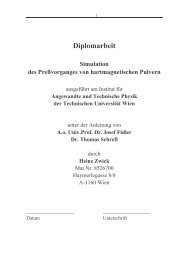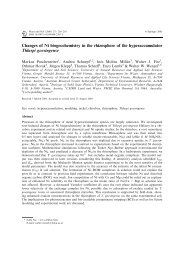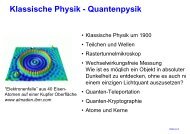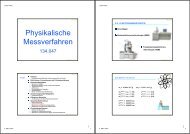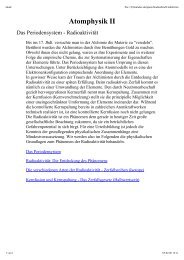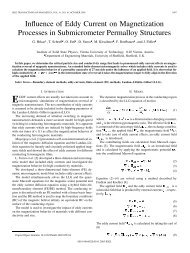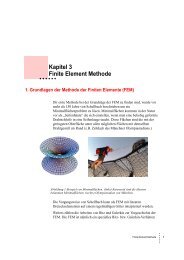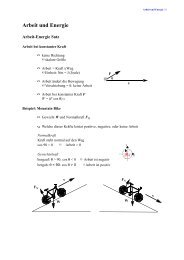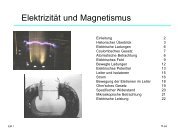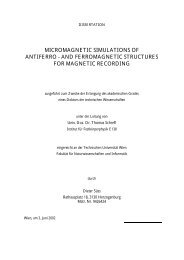Read Back Signals in Magnetic Recording - Research Group Fidler
Read Back Signals in Magnetic Recording - Research Group Fidler
Read Back Signals in Magnetic Recording - Research Group Fidler
You also want an ePaper? Increase the reach of your titles
YUMPU automatically turns print PDFs into web optimized ePapers that Google loves.
List of Figures<br />
List of Figures<br />
Figure 1.1: The orig<strong>in</strong>al draw<strong>in</strong>g of Oberl<strong>in</strong> Smith (1888) and Valdemar Poulson’s<br />
telegraphone [2].................................................................................................................7<br />
Figure 1.2: The first computer disk drive RAMAC. The pneumatically driven actuator<br />
arm and some of the 50 disks are visible [4].....................................................................8<br />
Figure 1.3: The development of bit sizes and storage densities over the last years [7]. ........10<br />
Figure 2.1: a) Illustration of the damped precession of the magnetic polarization J<br />
around the effective field Heff, taken from [15]. b) Influence of the Gilbert<br />
damp<strong>in</strong>g constant on the field rise time <strong>in</strong> magnetic read heads. Head field<br />
strength as a function of time for different Gilbert damp<strong>in</strong>g constants with<strong>in</strong> the<br />
head [43]. The dashed l<strong>in</strong>e depicts the current profile. The solid l<strong>in</strong>es give the<br />
head field for α = 1, 0.5, 0.1, and 0.02. The fastest field rise time is achieved with<br />
<strong>in</strong>termediate damp<strong>in</strong>g (α = 0.5).......................................................................................20<br />
Figure 2.2: The sp<strong>in</strong>-split bands of a ferromagnet [18]..........................................................21<br />
Figure 2.3: Giant magnetoresistance <strong>in</strong> Fe/Cr multilayers [18]. ............................................22<br />
Figure 2.4: Schematic model of a sp<strong>in</strong>-valve GMR head (CIP mode) with exchangep<strong>in</strong>ned<br />
layer and longitud<strong>in</strong>al hard bias [19]...................................................................23<br />
Figure 2.5: Change <strong>in</strong> resistance of a sp<strong>in</strong> valve compared to AMR (NiFe) vs.<br />
magnetization orientation [19]. .......................................................................................23<br />
Figure 2.6: The two different modes of a sp<strong>in</strong> valve. The current is applied either<br />
longitud<strong>in</strong>al (CIP) or perpendicular (CPP) to the layer structure [7]. .............................24<br />
Figure 2.7: Potential landscape <strong>in</strong>side the FM/NM/FM active part of a sp<strong>in</strong>-valve, for<br />
the two sp<strong>in</strong> channels <strong>in</strong> the parallel state (a,b) and <strong>in</strong> the antiparallel state (c),<br />
<strong>in</strong>dicat<strong>in</strong>g the different orig<strong>in</strong>s of scatter<strong>in</strong>g [20]............................................................25<br />
Figure 2.8: A comparison of longitud<strong>in</strong>al record<strong>in</strong>g and perpendicular record<strong>in</strong>g [7]. .........27<br />
Figure 3.1: A schematic 2-dimensional model of a read head for longitud<strong>in</strong>al<br />
record<strong>in</strong>g..........................................................................................................................30<br />
Figure 3.2: The magnetic potential at the ABS under Karlquist approximation....................31<br />
Figure 3.3: The x- and the z-component of the normalized head field of a read head<br />
with 60 nm gap, and sens<strong>in</strong>g layer thickness 5 nm, 10 nm below the ABS....................33<br />
Figure 3.4: The effective signal field as function of the relative position of the read<br />
head <strong>in</strong> respect to a perfect transition (Js = 0.5 T)...........................................................35<br />
Figure 3.5: These two figures show the x-component of the magnetization (Js = 0.5 T)<br />
of the data layer after a write process with head velocity 10 m/s (left) and 20 m/s<br />
83



